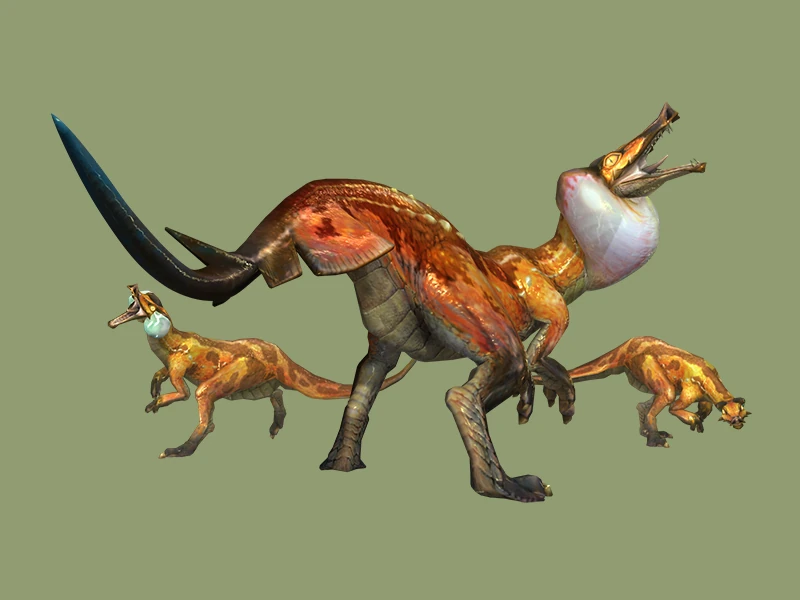 Social pack-hunting Bird Wyverns with orange, salamander-like hides. Inhabiting tropical rainforests and volcanic areas, they exhibit remarkable convergent evolution with the allopatric Iodrome and Ioprey. Females and immature males are known as Wroggi, while the large mature males are known as Great Wroggi. Wroggi have two small poison sacs behind their heads, but as a Great Wroggi matures these sacs fuse into a larger, more prominent sac stretching out under its neck. Great Wroggis also have bony osteoderms on their backs for protection and fin-like lobes on the sides of the base of their tails, [which are possibly used for thermoregulation. The slick mucus on the hides of both Wroggi and Great Wroggi may also play a role in thermoregulation, behaving similarly to perspiration.] As in the other species of social Bird Wyverns, each pack is only led by one alpha male and male Wroggi are chased away when they mature to look for another pack to usurp.
Social pack-hunting Bird Wyverns with orange, salamander-like hides. Inhabiting tropical rainforests and volcanic areas, they exhibit remarkable convergent evolution with the allopatric Iodrome and Ioprey. Females and immature males are known as Wroggi, while the large mature males are known as Great Wroggi. Wroggi have two small poison sacs behind their heads, but as a Great Wroggi matures these sacs fuse into a larger, more prominent sac stretching out under its neck. Great Wroggis also have bony osteoderms on their backs for protection and fin-like lobes on the sides of the base of their tails, [which are possibly used for thermoregulation. The slick mucus on the hides of both Wroggi and Great Wroggi may also play a role in thermoregulation, behaving similarly to perspiration.] As in the other species of social Bird Wyverns, each pack is only led by one alpha male and male Wroggi are chased away when they mature to look for another pack to usurp.Wroggi and Great Wroggi utilize their venom in hunting either by administering them through the fangs in their beaks or by spraying it out as a deadly mist. Great Wroggi are especially toxic, being able to spray larger clouds of poison which linger longer. [Their poison is crucial in allowing them to thrive in both of their preferred habitats. In the rainforest, their poison reduces the chances of prey escaping in the dense vegetation and allows them to capitalize on the plentiful Bnahabra population. As prey can be scarce in volcanic regions, their poison again increases the success rates of their hunts while allowing them to feed on Bnahabra when Herbivores are scarce.] Possessing venom is essential for Wroggi and Great Wroggi to take down armored and dangerous prey such as Rhenoplos, Bullfango and Slagtoth. Besides that, they are not averse to scavenging for carrion from larger monsters' kills. Large packs may even be able to harass larger monsters and steal their kills by spraying their toxic mist.
Being relatively low on the food chain, Wroggi have bright, aposematic coloration to warn potential predators of their toxicity. Other than that, their speed and agility usually discourages most carnivorous monsters from preying on them.
Wroggi are closely related to Baggi and Jaggi.